
4. Learning to Feel – Anticipation
February 9, 2024
Outcome Independent
March 26, 2024Former addicts understand how to celebrate small victories. People in physical rehabilitation understand how a movement so small and natural to some can represent weeks of hard and painful work when recovering from major injuries. Today’s story is about a very small thing that is very big.
I’ve had a strange experience that not too many people have had. After a spinal cord injury, a person’s spine needs to be completely stabilized to allow for healing. When cervical bones in the neck are broken, the new quadriplegic gets a “halo” screwed into their skull. Thankfully, as a paraplegic with a crushed and repaired lumbar vertebra, I only needed a removable body jacket. I learned how to put it on and take it off by myself in bed. Sometimes I’d wear a t-shirt over top of the body jacket so that I could pretend I didn’t have it on. It was awkward and reduced my mobility. Well, I guess that was the point. I felt naked and nervous when I was finally allowed to stop wearing it a few months after my surgeries. When something as precious as a spine is damaged, it is hard to trust that it is fully healed and moving freely is not just allowed but encouraged.
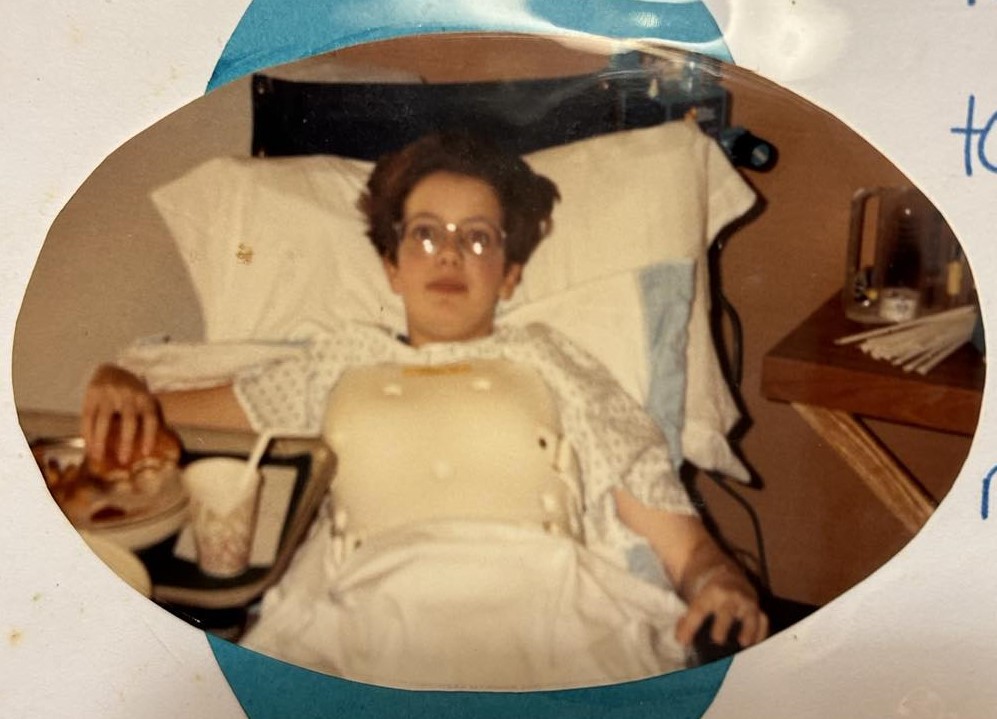
I would always be protective of my back. Subconsciously, I avoided too much twisting or bending. I guess that is a natural protective response. Not a big deal, right?
Soon, I got used to the feeling of being without the body jacket and could not believe I had managed to wear that nasty thing for so long. In the spirit of creating beauty from things that once held me in bondage, I painted it, and turned it into a planter with help from my dad. I donated it to the Occupational Therapy department at Harmarville Rebhabiliation Center with the hope that fresh spinal cord injury patients would smile at the thought that one day soon they would be free of their body jackets. It hung there for years. I remember seeing it in 1999 when I was an Occupational Therapy intern at Harmarville, teaching people how to do daily life activities in the gym – the same gym where I once learned how to walk.
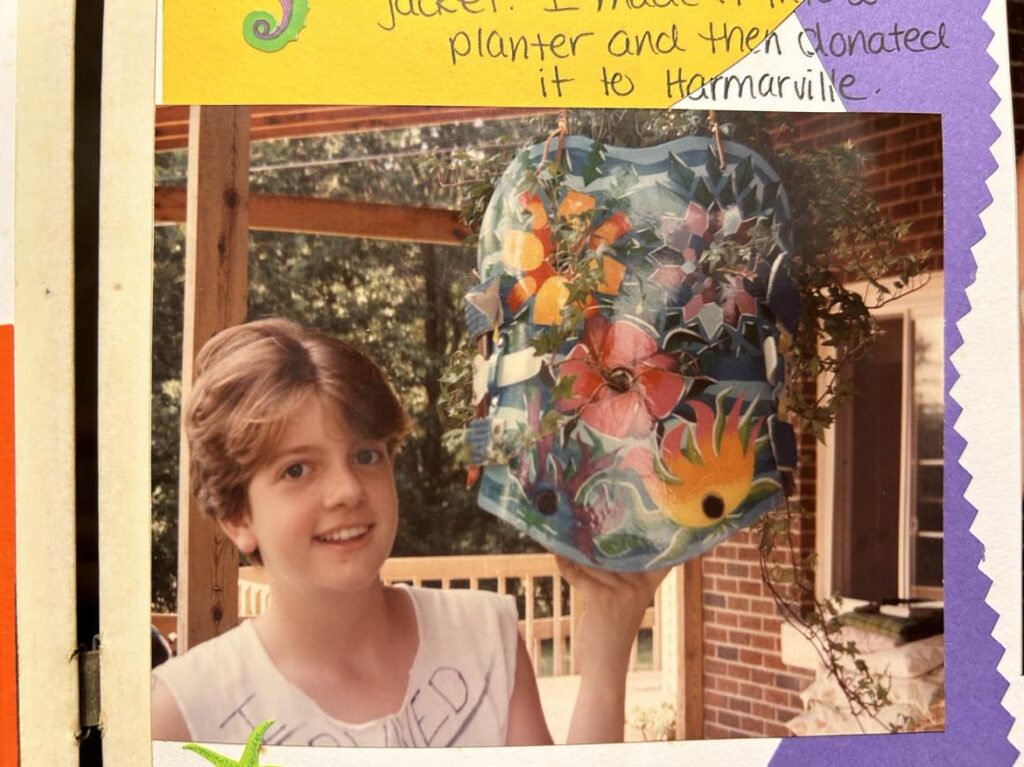
Twisting isn’t something we do too much in normal life. So, it wasn’t a big deal for me to avoid it, especially with the physical challenges already limiting my mobility. I was just happy to walk and lead a fairly normal life. I never even missed the twist!
Fast forward 25 years. My body started showing signs of heavy distress by 2017. It was saying, “No.”1 I had so much tension throughout my body that I could barely move. Three knee surgeries didn’t really help that tension and, most likely, increased it. After the final surgery, a total knee replacement, I realized I was stuck, and I needed help. I didn’t want to leave the house. The fear-pain cycle dominated my life. Joining a pain management class called SmartBody SmartMind (SBSM) helped me start to crawl out of my frozen, painful status. (More on SBSM another time . . . we have to get back to that body jacket.)
One day I started doodling a design. Very often, picking up a pencil and paper provides the beginning of a mental unfreeze. I may be stuck in self-pity, but the act of creating kickstarts my brain and positive thoughts once again begin to flow. I had no clue what this image I was drawing meant—I wasn’t even trying to make it mean anything but felt delighted by the shapes and connections that grew on my paper. Out of the blue (as I wasn’t feeling so very spiritual that day!), I felt God’s leading to form tight ropes out of the design. So, I did, and eventually a complicated rope system emerged. Tightly drawn ropes constricted and controlled the flow of air.
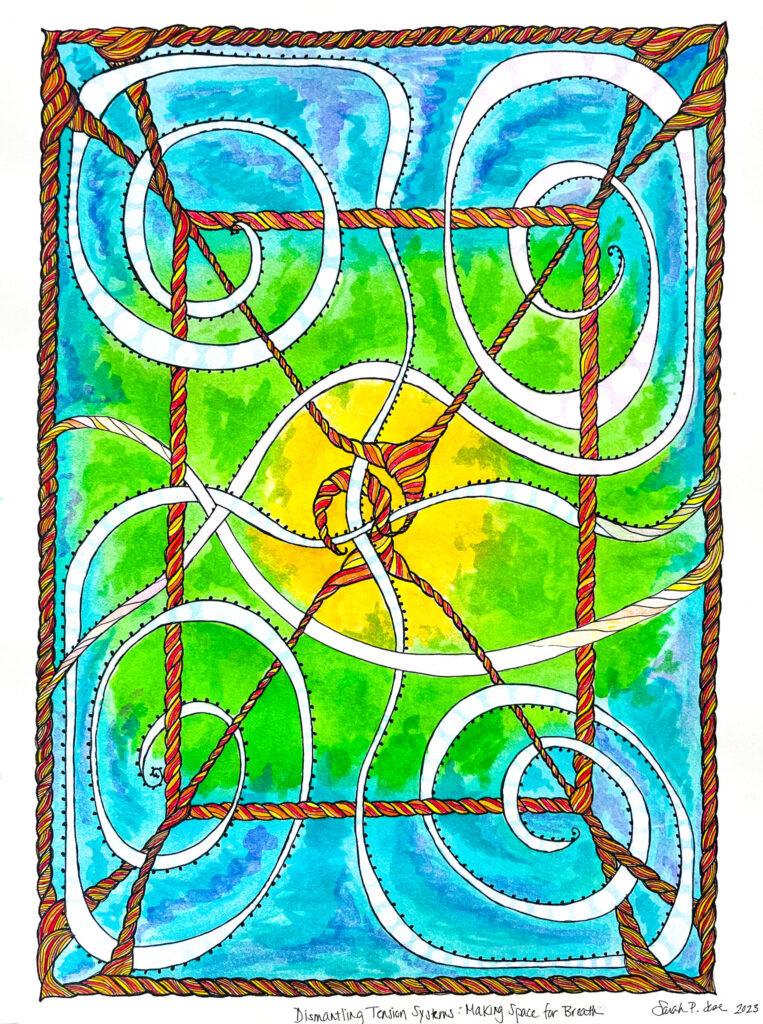
During the days I worked on this image, I also worked daily on new relaxation techniques for my back. Let’s call those practices “somatics.” I had often said I would do anything to get rid of my headaches. Would I faithfully do these somatic practices I’d learned? Coming out of pain is like taking a long, slow journey to an unknown destination. It takes time, and when you first start, you barely feel anything happening. Soon, God gave me the encouragement I needed to keep doing my body work. I realized quickly that the artistic tight rope system I had drawn represented my torso. Huh? Yes, my torso. Due to the trauma in my body and walking with an irregular gait for so many years, my torso was incredibly tight. My physical therapist could not believe how many knots I had in my back. Some of the knots in my hips were so hard that she said they felt like bones. I had somehow numbed this tension and pain and pushed on for so many years that all this came as a surprise to me. I was very out of touch with my body.
But there was a psychological element to this tension. Anybody can relate to the insecurity when a cast comes off a broken arm or when you are first allowed to weight-bear on a newly healed ankle. Despite the doctor’s assurance, we worry that we will re-break or damage the bones.
My body had become my body jacket.
My torso, now a strong network of knots and well-established tension patterns, worked hard to protect me and hold me together. My shoulders, overworked and underpaid, took on the job of the big boss when my legs were paralyzed. They pushed the wheelchair, transferred my body in and out of bed, held me up with crutches as I learned to walk . . . and they never stopped trying to hold me up. Sometimes I’d find myself checking out at a grocery store with my shoulders hiked up practically to my ears for no apparent reason. These dysfunctional holding patterns served no purpose other than to cause regular and intense headaches and backpain.
This may sound very strange to you. It sounds strange to me sometimes. In The Body Keeps the Score, Bessel van der Kolk helped me understand why I carry so much tension. “One of the ways the memory of helplessness is stored is as muscle tension or feelings of disintegration in the affected body areas.”2 We easily understand when we have wrong thinking patterns in the brain. Consider the child who was told repeatedly they were stupid. They grow to believe deeply they are stupid and unable to learn. They unwittingly cling to that helplessness. Much unlearning will need to take place before this young person can successfully take on any academic endeavor. Our bodies and muscles do the same because they are also controlled by the brain. Particularly during times of trauma, bodies dramatically learn physical lies, lies very hard to dislodge. You could say they respond to the lie of helplessness by becoming tense, holding on to whatever control they can find.
Without thinking, I protected my back by not twisting. With this subconscious protective response in place, I never even tried. My muscles faithfully offered their protective services.
Until it started to unlock.
We can unlearn trauma. Did you know that? Unlearning trauma is as much a physical job as it is a mental task. Once I started to dismantle my tension systems, it was like my body breathed a sigh of relief. Well, it actually did! When muscle tension dominates, no matter what the cause, we stop breathing freely. Our jaws clench, and we only use a small portion of our lungs (which nicely fill our torso when functioning well). Learning to loosen my torso and breathe well took a solid year of daily practice in relaxation techniques. I’ll link sites and list books below that helped me. For much of that year, I had to persevere, not really knowing if anything was changing.
A new image started to emerge. Could I begin to picture my torso in a different way? Now, cool colors (blues and greens) represent me better and I can do the twist! I’m not brittle with shoulder and back tension anymore. When stress does come in, I know now what to do with it. I still spend time daily reducing my tension. I will probably need to keep doing this for the rest of my life. Is it worth it? Yes. Everyone should do it. Compared to feeling like a twig that could snap given the perfect (small) amount of pressure, this feels very good. Proof of the change comes in the fact that I can think about the future without shutting down or crying!
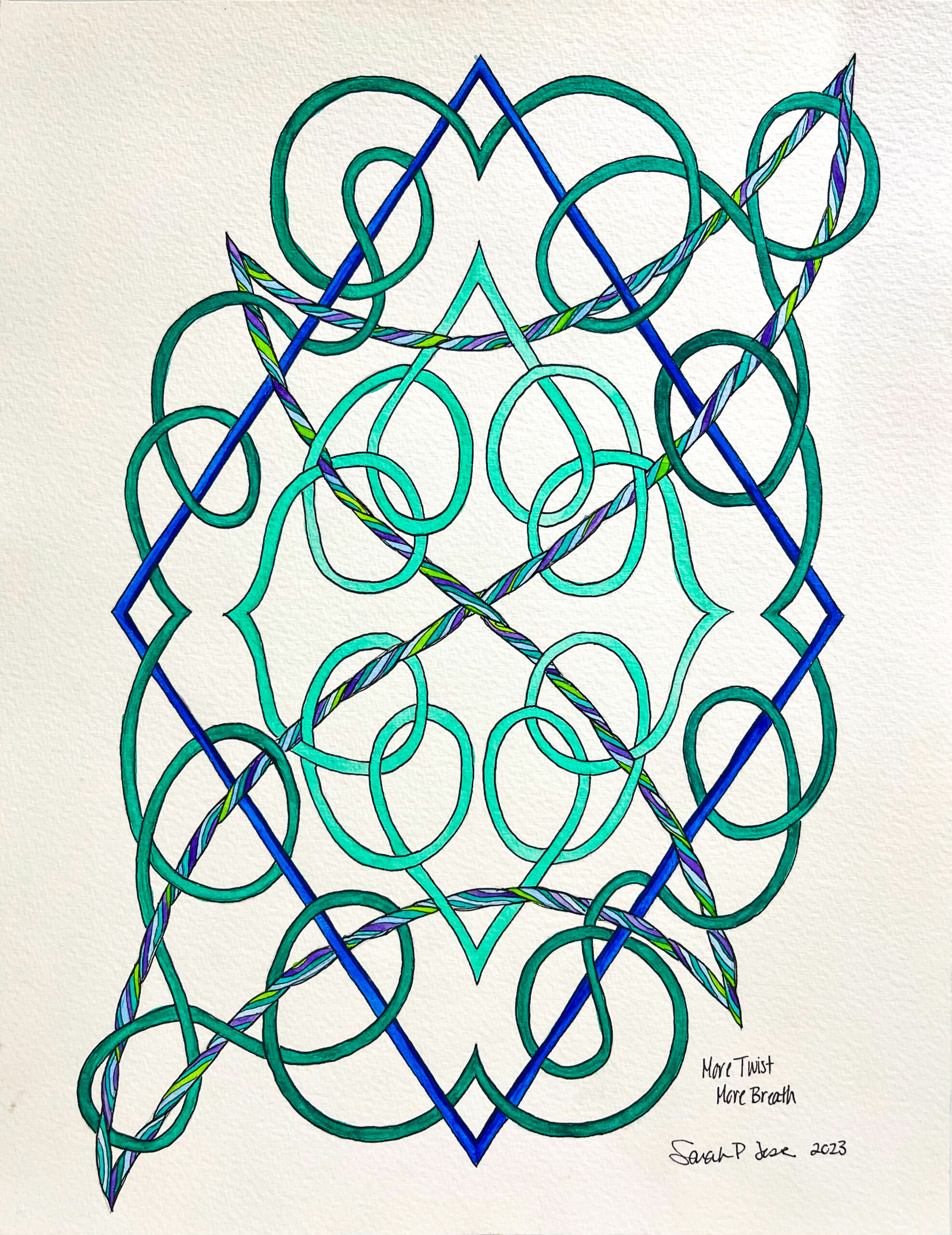
The moral of this story: I wonder what other subconscious behaviors or thoughts remain in me . . . leftovers from my trauma and rehabilitation, or life challenges in general. I wonder what protective responses I have that I don’t need anymore. How about you? How can you relate?
Websites and Programs that helped me:
Irene Lyon: https://irenelyon.com/
SmartBody SmartMind: https://smartbodysmartmind.com/
Inspire Somatics: https://inspiresomatics.com/
Tip: Spend time (I spent months) looking at and practicing the free resources on these sites before purchasing any programs.
Endnotes:
-
- Maté, Gabor. 2019. When the Body Says No: The Cost of Hidden Stress. London, UK: Penguin Random House.
-
- van der Kolk, Bessel A. 2014. The Body Keeps the Score: Brain, Mind, and Body in the Healing of Trauma. New York, NY: Penguin Books. Pg. 318.

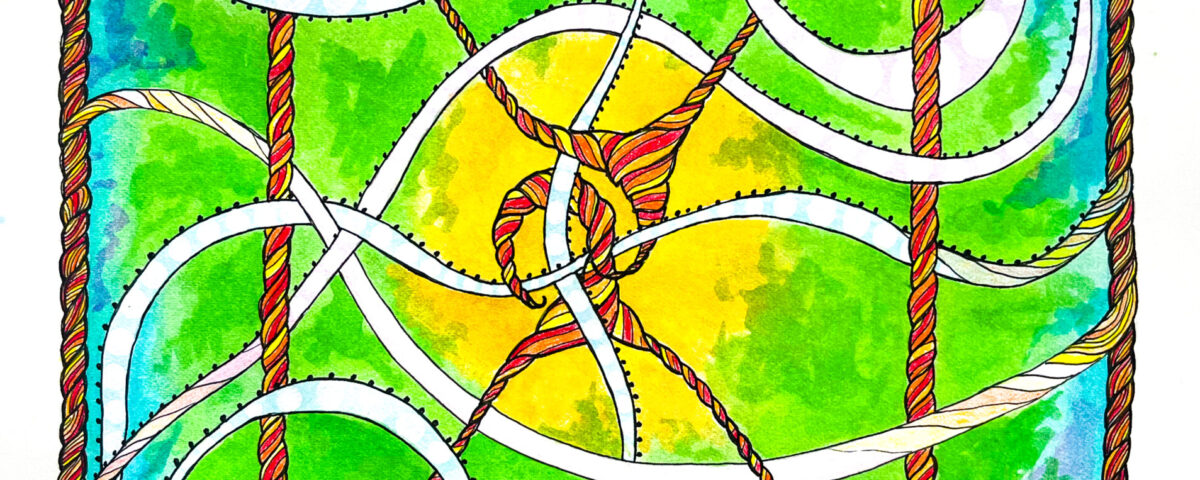

7 Comments
Thank you for your kind words, Eric. All your videos helped me untangle the tension in my upper body. I still practice every day!
Sarah,
Thank you for sharing this beautiful telling of your story. As you say:”Unlearning trauma is as much a physical job as it is a mental task.” That’s so true. They intertwine.
I think you see value and have created growth out of the challenges that you have had.
You’ve grown so much, and overcome so much.
Thank you for your kind words, Eric. All your videos helped me untangle the tension in my upper body. I still practice every day!
Sarah, I enjoyed reading your essay very much. Your ability to face your pain and trauma with both humility and hope is an inspiration. The practical, dogged steps you are willing to pursue toward health and healing is likewise impressive. It seems apparent that the Holy Spirit is guiding you to both desire and achieve your intermediate goals. Thanks for generously sharing that journey with the rest of us. Our struggles may be very different in kind but essentially, they share in common the need to foster hope for progress and perseverance taking steps toward incremental progress. Thanks for the encouragement!
Jim, Thank you for your kind words. I guess you might even remember my body jacket! I know you understand how important incremental progress is. It can be discouraging because it is so slow, but as long as we are moving in the right direction, it is still progress! I definitely believe in small victories.
Wow, thank Sarah for this powerful lesson.
You have opened my mind on certain things I could not understand before. I have answers.
I believe that your articles are blessings many people.
I pray for more anointing on your articles .
Thuram, I’m touched that you took the time to read my blog. How special that through my words you gained insight. We sure have enjoyed having you around over the last season!